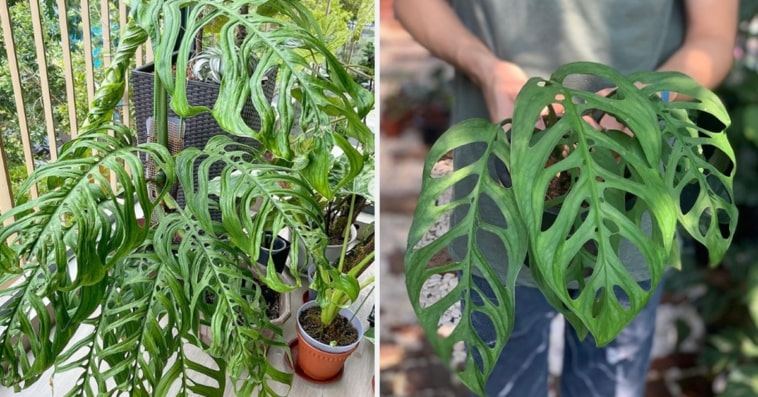Garden
Care and Growing Tips for Monstera Epipremnoides – A perfect Indoor Houseplant Giant
Like other plant enthusiasts, we love cute little plant monsters and we mentioned some houseplant monstera varieties that you can grow at home without any problems.
Monstera epipremnoides is no different. A species of flowering plant in the genus Monstera in the family Araceae, endemic to Costa Rica, it offers a beautiful window of leaves just like its other sisters.
- Monstera adansonii (unproblematic current sibling of Monstera epipremnoides)
- Monstera obliqua (Monstera epipremnoides sibling the rarest and hardest to find)
- Mini monstera (Rhaphidophora Tetrasperma, dwarf and houseplant brother of epipremnoids)
All monsteras are called Swiss cheese plants because of the cheesy holes in the leaves.
Monsteras are aroids, offering large leaves with windows and growing like decorative climbers; This is what confuses plant enthusiasts to distinguish Monstera epipremnoides from its siblings.
are you one of them? Do not worry!
Here you will get an idea of what Monstera epipremnoides is, how it differs from its sister plants, and Monstera epipremnoides would like to see it develop without difficulty.
Table of Contents
Identifying Monstera epipremnoides:
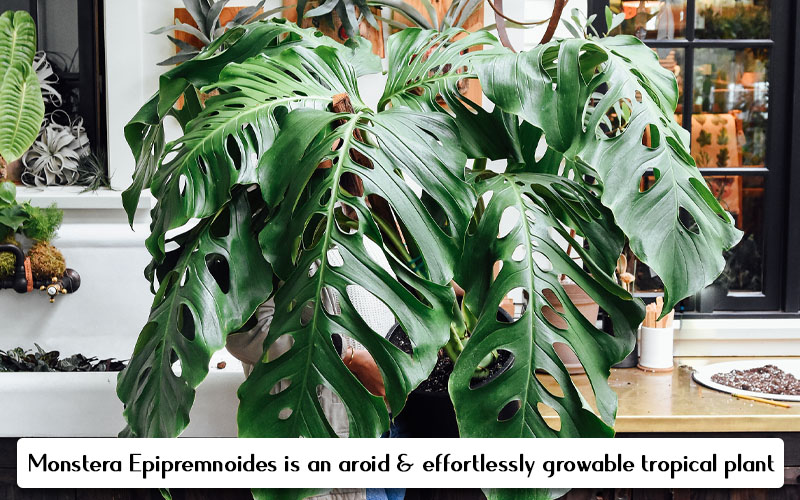
Epipremnoides goes by another name – Monstera esqueleto
Monstera Epipremnoides is an aroid and effortlessly grown tropical plant that requires little maintenance indoors or out – sometimes called XL monstera epipremnoides because of its giant size.
When the plant is new to your home, you may need to be a little more careful as you and the plant are trying to keep up with the environment and other things like watering, soil, light, temperature. time.
Scientific profile:
- Family: Araceae
- Genus: Monstera
- Species: epipremnoides
- Binomial name: Monstera epipremnoides
- Type: Houseplants / Evergreen
Plant profile:
- Leaf: glossy, leathery, broad, heart-shaped leaves
- Stems: long and thick
- Fruit: Yes! White/aromatic
- Fruit Type: Berry
“Monstera epipremnoides fruit isn’t edible.”
Care Profile:
- Care: Easy but regular
- Can we grow indoor? Yes!
The most distinctive feature of Monstera epipremnoides are the inflorescences or flowers, often called spadix.
Monstera obliqua also forms spadix flowers and perhaps people confuse epipremnoides with it; but both are different species from the same family/genus.
The features that distinguish it from the rest of the monsters are:
- Leaves are larger than adansonii or obliqua
- bicolor leaves
- Half washed or bleached leaves
Disclaimer: Some experts say Monstera epipremnoides is different, not the actual plant. However, we don’t have much information to agree or disagree with this claim.
Monstera Epipremnoides Care:
Here are the best, easy-to-follow and proven care tips that you’ll have no trouble adopting when caring for your plants.
1. Container:
A terracotta pot made of mud, not a plastic or glass pot, is best
Containers play a role in helping a plant grow. Often people complained that Monstera Epipremnoides did not grow.
Wrong choice of container may be the reason. So check it out and make sure you’re using a terracotta pot made from mud. The plant likes a cold house and mud pots can be kept cool with very little misting from time to time.
2. Soil:
Well-drained, breathable but not wet
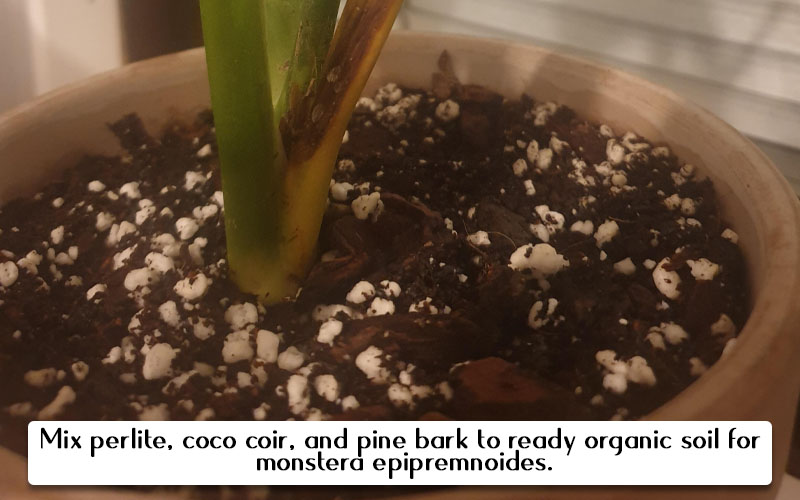
Prepare your plant’s soil yourself, but make sure it is well-drained, moist and breathable for the plant.
The ingredients you will need to make a rich organic blend are: perlite, coconut coir, and pine bark.
To avoid mess, you can get a soil mixing mat and mix the ingredients well before pouring them into the pot.
Avoid using dry, sandy or muddy soil and at the same time prevent water from reaching the roots or root rot may occur.
Tip: If water is coming out of the pot right after watering, it is an indication that your soil is well-drained.
3. Placement / Light:
Germinates well in indirect light
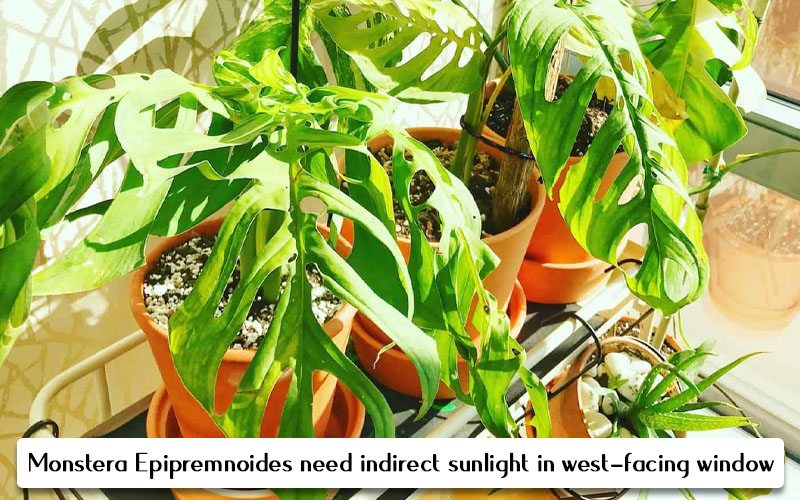
In the jungles of Costa Rica, epipremnoides monstera grows under forest canopies, which means that even the wild species outdoors love indirect sun. Mimic the same environment indoors.
Find a sunlit room and set your epipremnoids across the floor so they stay in the light but not in the scorching sun rays.
It’s okay to play for hours in the direct sun, but more than 6 hours can burn the leaves and definitely ruin the beauty and health of your plant.
Even in nurseries these plants are grown under canopy.
4. Watering:
Watering once a week is sufficient.
We think all plants like Scindapsus pictus need watering every day, but not epipremnoides. A slow watchdog, a plant for lazy growers, just like Prostrata peperomia.
But that doesn’t mean you keep it dry and expect it to come back to life like a rose of Jericho plant.
Overwatering and overwatering are both equally harmful. Overwatering can cause root rot, while underwatering can cause your plant to not be fed.
Avoid both situations.
5. Temperature:
Monstera epipremnoides likes milder temperatures and humid locations.
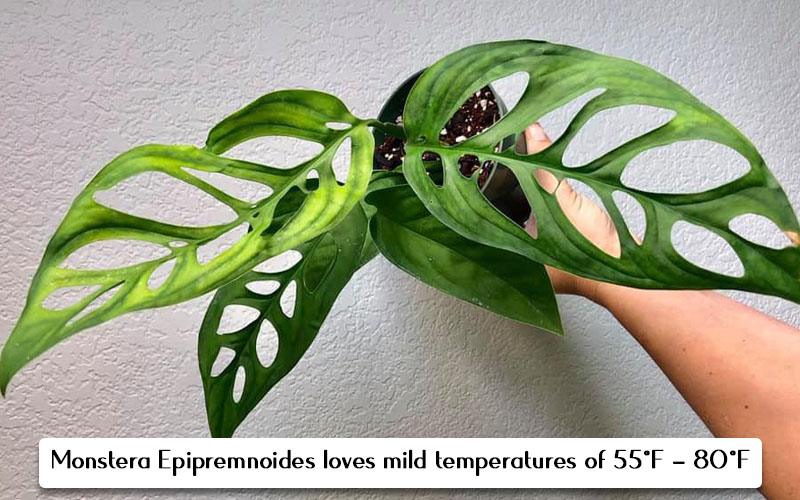
They will need humidity around them, so a temperature between 55°F – 80°F is quite suitable. You can look back at the environment where these plants naturally grow to maintain warmth.
Monstera epipremnoides is also found in high areas; therefore, they like mild to cool temperatures.
6. Humidity:
Monstera Epipremnoides likes to stay in moisture
Monstera Epipremnoides needs moisture, like other ornamental plants, for example, purple waffles.
You will need to maintain very high humidity around your plant as it will not only help Epipremnoides thrive but will also keep insects away.
For this,
- Humidifiers can be used to increase humidity
- You can also place your plant in a tray of gravel and mist regularly to improve the moist environment around your plant.
- Or keep your Epipremnoides pot near other plants for adequate moisture.
By doing this, you will find that your plant is growing very bushy.
7. Fertilizers:
Diluted fertilizer is best – don’t go with slow fertilizers
Using the wrong, accessible or poor fertilizer can kill your plant. So be smart when giving it to your plant.
The most comfortable to care for, Monstera Epipremoides only needs fertilizers made three times a year during the growing season.
Be sure to apply fertilizers to the top edges and hold them from the bottom or base. For this, be careful not to water your plant for at least one day after watering it with nutrients.
8. Pruning:
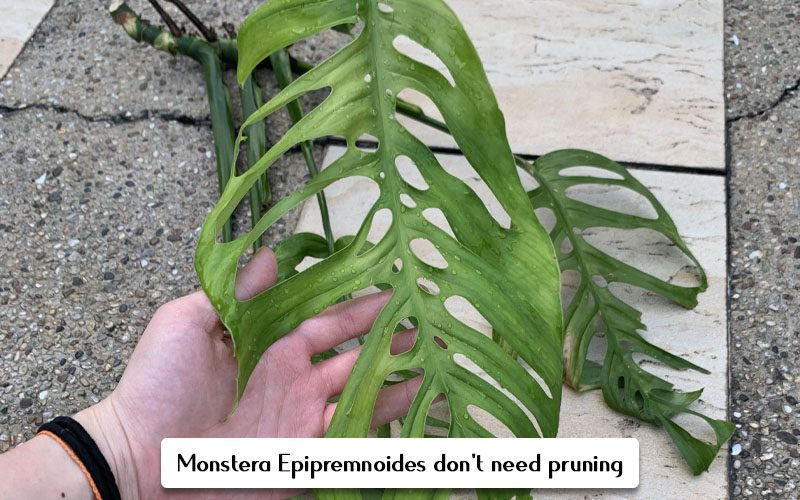
Who can prune and cut leaves and branches with such windows?
Noone!
Therefore, epipremnoids do not need pruning at all. Even if you see some leaves turning yellow, be sure to use some remedies to bring them back to life rather than pruning them.
You won’t want to lose a leaf of this slow grower.
Propagation or growth of Monstera Epipremnoides:
Reproducing your Monstera epipremnoides is not a difficult task, as you can even use tap water to get started.
Usually, Epipremnoides is propagated by cuttings and is the easiest method of propagating your plant. For this,
- You need a healthy stem from your plant, which may or may not have leaves on it.
Be sure to start rooting before planting it in its burrow for next year. For rooting you can:
- Put your plant in diluted chemical-free water
- plant in sphagnum moss
- Putting in normally moist soil
- root in perlite
After a week, remove the cutting and plant in the container; This house. After the process is completed, apply all the maintenance methods mentioned above.
Diseases and Pests:
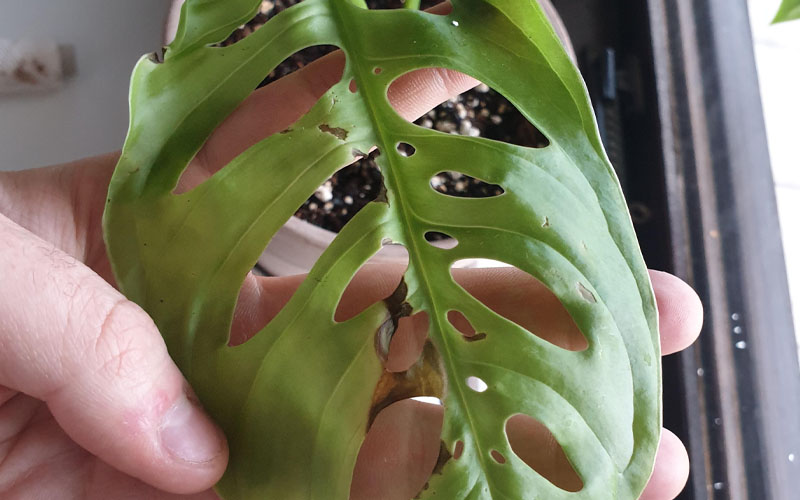
Your Monstera epipremnoides is prone to certain diseases and, like its other monstera brethren, is attractive to house pets and insects. Like:
- Fungal spots
- Leaf spots
- Root rot
Insects that are most likely to attack your plant:
- Scale insects
- Spider mites
- Mealybugs
- Houseflies
Increase the humidity around your plant to protect it from insects. Water as needed, maintain warmth and brightness around your plant to simultaneously prevent disease.
Toxicity:
Almost all Monstera plants are toxic to pets and humans, and epipremnoides is no different. It is better to keep this plant away from children and animals.
Don’t be fooled by their beautiful, aromatic berry-like spandex, as they are poisonous and can cause serious health problems, like 15 Fascinating But Poisonous Flowers You May Have in Your Garden.
Bottom Line:
Monstera epipremnoides ends discussion here. Do you have any questions in mind? Feel free to write to us, we will reply to them as soon as possible.
Happy Planting Traces!
Also, don’t forget to pin/bookmark and visit our blog for more interesting but original information.

